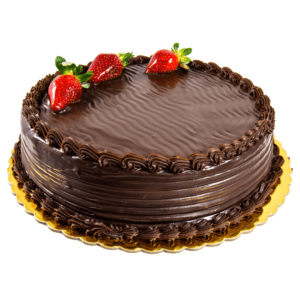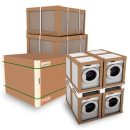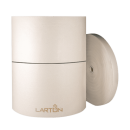News
22 October 2021
Packaging Paper
In a world where the works are usually eliminated in accordance with their packaging, the package should be functional and durable as well as attractive, and help to protect the quality of a product till it is delivered to it is delivered to its buyer. The word of packaging covers various meanings. This is the most common method that you should follow to store, sell and distribute your products. In addition, the packaging refers to the logistics relating to transporting the products. Such this packaging paper protects the products, informs on the products, helps to transport and advertisement. Thereby, it is mandatory for all businesses to have knowledge of packaging and its varieties.
There are a lot of packing papers that are specially produced for the products being needed to wrap.
The packaging paper can be bought from packaging manufacturer and sellers. You can reach easily these companies from e-commerce sites (i.e. ambalajcim.com, kolicim.com).
Untreated Third-Grade Paper Pulp
The production process of packaging paper starts with the paper produced in the special facilities from third grade pulp, which is wood pulp. The paper pulp is generally made from the trees qualified as softwood.One of the usage areas of this paper is gift packages. For a gift package, the paper is bleached, however other packaging papers such as kraft packaging materials (known as shopping bags) are made from unbleached pulp. Inks are made from natural and synthetic dyes. The emphasis on environmental protection using recyclable papers is produced by both the papermaking and inking industries, which select bleach and pigments that are readily recyclable.
The strength of gift pack manufacturers can be in design over actual paper and ink production. The gift companies buy paper and ink from the sellers specialized in the packaging paper (it is named as giftcote in the industry) in two different weights, heavier kraft and paper tissue. Finished surfaces of certain wrapping paper such as foils are printed on the paper during the printing process.
Transition to Paper Packaging
Digitalization has substantially affected the printing industries. The information obtained via digital media responds quickly. This will absolutely affect the usage of the products of paper industries.
In order to keep in step with the digital world, packaging paper products tend to the alternatives which are directly or indirectly linked to digitalized markets. These products play a mutually effective role in balancing among industries.
Paper manufacturers are in continuous development to meet the requirements of digital companies by providing products such as packaging paper. The packaging industry is still a huge one in the market and includes shipping, logistics, food and much more industries as well.
Packaging Paper in Digital Markets
As digital markets are now focused on better services in less time, the industries like e-commerce need different packaging papers to meet requirements. E-commerce provides effective supports to the paper manufacturers for meeting these requirements.
It is required different packaging papers for different products.
As many online stores sell and deliver a great number of products, they need high quality packaging for safe delivery.
The choice of paper quality depends on the quality of packaging in accordance with the sold product. If a luxury product is packed, then it is used a packaging paper in a higher quality for meeting the requirements. It is used a packaging paper in a less quality for small or non-luxury products. In addition, the prices of packaging papers differ according to the type of packaging papers.
What is the Paper Package?
The paper package is a kind of packaging product, which is made from paper material that is quite popular nowadays. Such packaging is used for packing, storing and transporting, and helps for storing and protecting the products. Currently, such packaging manufacturers are interested in investing in designing new and beautiful models and adding branding functions.
The Production Process of Paper Package
Production phases for a gift package are relatively easy once a design has been developed and approved.
Paper, ink, special coatings and other items in the design line are purchased from paper and ink sellers. These materials are inventoried at the manufacturer’s printing facility. A computer file containing the image digitalized by the design team is read by a machine that processes the image onto a printing cylinder.
Design is the key to the packaging paper that acts as an attractive gift package of a good product to be sold. The design department of a major gift package manufacturer consists of line designers, graphic designers and artists. Line designers create initial ideas for specific gift package types and all related specials. Line designers design tissues, bows, ribbons, gift boxes, wrapping paper, stickers or seals depending on their concept.
Graphic designers are also involved in design planning, but their primary task is to create artwork that will be used to make a template to be repeated on the surface of the gift package for the printer or paper mill. If a familiar image such as a cartoon character on coloured packaging paper is used, the designer works with the artist or the company who has provided the image in order to develop a series of designs by using that image in accordance with copyright laws. The finished designs are reviewed and approved, then scanned into computer registration that can be shared with the paper mill, printer, and the other persons responsible for the production, thus similar and correct designs can be reproduced.
Meanwhile, the line designers directly carry out to complete the designs for other parts of the line. The gift labels rely widely on the gift package designs, so it is coordinated like this. However, the label designing is so complicated because the small areas restrict the designing options, and producing many special surfaces or patterns is expensive. Gift bags are also a big part of the gift package market. Again, designs for gift bags can be based on gift packaging paper plans or card lines. However, the different gift packages can also be designed.
The pressing cylinder is carefully inspected and installed on a printing machine. Presses use the processes of rotogravure or flexography. While the rotogravure requires abraded rollers, the rubber plates attached to a rotating roller are used for flexography. Gravure printing is used to decorate packaging paper.
It requires unique inks for each process. Gift package manufacturer have high technological printing equipment that can apply up to six different colors at the same time, and add special coatings such as foil, nacreous and flocked coatings. When outputting from the pressing, the paper is transferred in large rolls to another area in the factory. The machines can cut and wrap the paper into much smaller rolls, or fold it into flat packs for sale.
The gift package rolls are immediately shrunk with pre-printed transparent packaging that carries the manufacturer’s information and price. The flat packs are also wrapped and closed. Both types of gift packages are packed in cartons for shipping to card shops, departmental stores and other retail outlets.
- The raw materials of packaging paper are roll paper. Paper will be put into corrugated machine to make sheet paper (semi-finished paper).
- Then, the necessary information to create a semi-finished paper 2 will be put into the printer, usually using the flexo printing method.
- After printing, the paper will be put into stamping and slot machines to form the finished cardboard.
- The finished cardboard sheets will be punched and the carton closing machines will form the finished cardboard packages.
- Finally, it will be checked for quality before delivering to customers.
Quality Control
As gift package production needs intensive design processes, the quality of most product is taken into account before arriving the production facility. All employees are responsible for product quality while the product is processed in their area. In addition, quality control specialists are part of the review and approval process during design and play an active role throughout the production process.
Recycling / By-Product / Waste in Paper Packaging
Gift package manufacturers produce product lines for birthdays, weddings, Christmas and many other holidays and special occasions. Each edition includes all the appropriate accessories that customers might need for a specific situation, and the lines should be designed to appeal to a wide variety of tastes.
The paper is the largest waste material and all waste paper is sold to recyclers, who grind it, remix it with suitable pulp types and regenerate paper from it. Ink waste is caused by residual ink that is not fully used by printing a specific line. Inks are chemically transformed into new colours, and they can be reused. The other manufacturers who buy ink from subcontractors recycle this ink.
Recycling and Demolition of the Packaging Paper
Cardboard – Cardboards are heavier paper boxes that have a wavy centre. During recycling the package can release the tape. The wooden should be flattened in order to squeeze much more recycling bin or vehicle.
Cardboards – The cardboards such as fruit juice boxes, milk boxes, soap boxes, beef broth boxes and wine boxes are made from high quality papers. They should be rinsed properly.
Boxboard – This board is used for packing wheat, cake, gifts, medicines, bath materials, shoes and toothpastes. All plastic coatings should be removed before recycling.
Note – Some non-recyclable paper products such as pizza boxes or the others got dirty with oil or other materials can be composted in organic collection programmes.
Common Paper Packaging Types
First Grade Paper Packaging
The first grade paper packages are essentially used in milk industry with the production in high standards. But the fermentation of the milk is easy, and if it is not packed, it will be damaged. In addition, it is difficult to preserve properly the products that should be saved with the multi-plied packages in high standards.
Paper Cardboard Packaging
This packaging is the biggest section of paper packaging types, and is seen frequently in agriculture and industries.
Paper Box Packaging
This is a smaller segment than cardboard paper packaging, but with the production process, it has a large number of different categories to meet the needs and different tastes of users. Complex from the printing, papermaking, sealing, box-forming stages of product packaging lines to meet modern packaging stages, this segment appears popular in familiar consumer goods for daily life such as confectionery, tea industry, coffee.
3-5 Layered Kraft Paper Packaging
This packaging type is a very specific product group used in some basic sectors such as cement, chemistry, construction, flour, fried flour in the industry. , It is used in food with a capacity approximately 10 to 50 kg.
PP Plastic Kraft Paper Packaging (KP Packaging)
This is similar to kraft paper packaging with 3-5 layers. However, this is a new type of packaging containing superior properties PP plastic. Being strong and robust helps the product to be protected better and more easily. Due to its transport durability, the number of material layers and material cost are reduced significantly.
Paper Packaging with PP Plastic (Kraft, Ford, Couche) Offset Printing
It is a very special product group in the field of paper packaging. More precisely, This type of package is a hybrid product between a paper package and a plastic package. In the field of plastic packaging, people usually use gravure printing technology to print directly on a material called BOPP to create an eye-catching packaging product. A large initial cost is required to invest in the printing axis of copper pipes. This is a important alternative to not investing in print axil costs. Instead of printing direckly on BOPP paper, Ford paper or Couche paper that will be replaced or printed with offset technology can be used. The investment cost of offset printing is 20 times lower than the investment cost.
Shipping / Shipping Packaging
These kind of packaging, is used to ship bulk products or smaller products and I,nner packages from one place to another. There are many types of packages to ship products that can be customized according to the company’s requirement. Below are some examples of shipping packages;
Cases;: cases and pallets are an essential packaging option for shipment. They keep main goods safe and help to remove them from the surface to prevent any damages. Thus, it provides protection against dirt and moisture.
Vacuum Packaging::This is a great packaging idea for sealed products. Therefore, it is a good option for food products. It helps to eliminate bacteria and yeasts. In addition, vacuum packaging helps food stay fresh longer in the freezer.
Shrink Wrap:This is a versatile packaging option. You can wrap it around the actual product or in an entire pallet or product case. This can help hold them together and make them easier to move around. In addition, it provides protection against impacts, punctures and abrasions. It also gives the package a unique visual appeal. Most importantly, its cheap prices make it low cost. Thus, it can greatly reduce shipping prices.
Shock Proof Packaging: Shock mount packaging is the safest option for fragile items. This is because it includes built-in shock absorption to protect the contents. In addition, it protects the products against vibration, moisture, dust and moisture. It is often used to package electronic equipment or unstable chemical compounds.
Consumer Packaging
Once the products are shipped to the desired destination, the next step is to transport them to markets and retailers. But first, they also need to be packaged here to facilitate transport and provide protection. There are many packaging techniques used to ship products to consumers in bulk and individually.
Corrugated Cardboard Boxes::These boxes are often used to pack and transport heavy items such as electronic devices, tools, wine, fruit and vegetables. What’s more, wholesalers use them to package bulk products. Besides, they are strong and durable due to their layered paper materials. Its main strength comes from the wavy ripple in the middle. Because of these fluctuations, these are called corrugated wrapping paper. Most importantly, these boxes are environmentally friendly. They can be reused and recycled for different purposes. These boxes are stronger and more durable than cardboard boxes but are often mixed with them.
Paper Cardboard Cartons:Paper or cardboard boxes are often used to package single items such as shoes, crackers, toys or breakfast cereals. This is because it is not as strong as a corrugated box, but is lighter and accessible. Besides that, its lightweight design makes it an ideal packaging device for on-the-shelf items. Also, printing and graphic design is easier and more effective in this box. Thus, while providing efficient protection to your products, it can have eye-catching and attractive profiles. Most importantly, you can reuse and recycle them in the form of art, craft and writing paper.
Paper Bags:Paper bags are the most common packaging items. Used to pack your food at your local supermarket, allow you to take your food from a restaurant, and carry flour or cement, these bags are versatile. Besides that, paper bags help save money and you can print them beautifully to increase the aesthetic demand of what you sell inside. In addition, they do not cause environmental pollution like plastic bags. It can be easily separated, renewed and recycled to produce more paper. Paper bags are a great choice for your product packaging.
Plastic or Polyethylene Bags:This is the cheapest packaging material on the market. It is quite durable and functional with this. It is generally used in food, plant, flower and newspaper packaging. Most importantly, they are more widely used, and most retail store owners and small businesses use them as their primary packaging medium.
Food Wrapping Paper
All types of food, from sandwiches to steaks, must be properly packaged to maintain freshness and ensure safe processing. Knowing what type of food wrapping paper to use for your application is crucial to delivering a quality product to your customers. Paper and cardboard are generally used in corrugated boxes, milk cartons, folding cartons, bags and sacks, and packaging paper. Tissue paper, paper plates, and cups are other examples.
There are different types of paper used in the food packaging industry. When used as primary packaging (i.e. in contact with food), paper is treated, coated, laminated or impregnated with materials such as wax, resin or lacquers to improve its functional and protective properties. Many different types of paper used in food packaging are as follows:
Parchment / Baking Paper: Made from acid-treated dough, acid adds some wet strength by modifying the cellulose, making it smoother and impervious to water and oil. It is not a good barrier to air and moisture, cannot be sealed with heat, and is used to package fats such as butter and lard.
Oiled Paper:Greaseproof paper is used to wrap snack foods, cookies, candy bars and other greasy food, and is a product that is replaced by plastic films.
Kraft Paper:Kraft paper is available in a variety of forms: natural brown, unbleached, heavy-duty, and bleached white. Natural kraft is the strongest of all paper and is often used for bags and packaging. It is also used for packaging flour, sugar and dried fruits and vegetables.
Corrugated Cardboard: Corrugated cardboard is made with 2 layers of kraft paper with a central corrugated fluting paper. The fibreboard’s resistance to impact abrasion and crush damage makes it widely used for bulk food shipping and crate packaging of retail food products.
White paper roll for food industry:paper for food industry or kraft paper is a kind of rough, sturdy paper that is ideal for wrapping meat and fish. It is widely used among fishermen, butchers and even artisans. Most butcher wraps are sized for wet strength and leakage resistance; however, larger rolls such as 24 “, 30”, and 36 “sizes are traditionally left untreated (they are often used for craft or tablecloths) as they are not usually used for meat wrapping. Makes meat look fresh Lets meat breathe, hides juices and is made from unbleached fibres Gives meat a clean appearance Versatile, can be used to wrap meat and sort serving trays / baskets.
Green paper roll for food industry:It is used in meat and fish display. It can prevent meat and fish from becoming slimy. It helps the meat maintain its fresh color. Used for barbecue and smoked meats.
Freezer / Coated Kraft Paper:Like paper for food industry, freezer paper is a rough, sturdy type of paper. Contains low density polyethylene laminated on one side to provide strength, seal and prevent freezer burning for up to one year. Ideal for packaging and storing fresh fish, poultry and cheese, as well as pre-packaged deli products such as packs and sandwiches. Also, freezer paper is great for packing noodles and is widely used in the pasta industry. Freezer paper is great for preserving freshness in both the fridge and freezer. Freezing paper is good for writing on with pen, pencil or crayon, but can only be written on the outside due to the poly coating.
Sandwich Wrapping Paper:Traditional sandwich wrapping paper has a fully open style, making it ideal for wrapping sandwiches, hot dogs and sausages or lining serving baskets. It can also be used as hamburger wrapping paper. Some sandwich wrappers have a double open design and are perfect for wrapping flat items such as pastries, pretzels, and cookies. This type of paper also acts as a cone basket liner for versatility.
Wax Paper (White Greaseproof Paper Roll):Wax paper or paraffin paper is a type of paper that has been treated with wax to ensure it has a smooth surface that prevents other items from sticking to the paper. By applying wax to the paper, the paper becomes resistant to moisture transitions in both directions, keeping damp food wrapped in this type of paper hydrated, and preventing dry wrapped food from exposure to moisture. The wax paper is fine to write on sharply and is tape-friendly.
Wet Wax Paper and Dry Wax Paper:Dry wax paper is a type of bleached kraft paper that is subjected to a dry waxing process that pushes paraffin into the sheet and leaves no surface residue. Dry wax paper is perfect for hot food applications such as sandwich wrapping and pizza boxes, as the wax coating is printed on the paper and therefore won’t transfer to your product. Like dry wax paper, wet wax paper is a type of bleached kraft paper, but instead of dry waxing, wet wax paper is subjected to a wet wax treatment on both sides for a high-gloss water-resistant finish. Wet wax paper offers an excellent packaging material for chilled food products such as sandwiches and vegetables, and can basically act as a waxed butcher paper for poultry, fish, steak and meat. It is also widely used in the confectionery industry as dip paper or tray liner.
Interfold / Unfold Wax Paper:Pop-up waxed paper sheets are made of dry wax paper and provide a quick and easy way to pack a variety of products in your grocery store, deli counter or convenience store. These sheets are folded and packaged in a “Pop-Up” box for easy distribution from the top of the counter. Pop-up waxed paper sheets are made from dry waxed paper and provide a quick and easy way to pack a variety of products at your convenience store, deli counter or convenience store. These sheets are folded and packaged in a “Pop-Up” box for easy distribution from the top of the counter.
Patty Paper:It makes it easy to prepare, pack and sell your own prepared hamburger patties. Like waxed paper between layers, meatball paper is made from dry waxed paper. It is placed between the meatballs to prevent the meatballs from sticking together during preparation and storage. Patty paper is especially useful in freezer applications.
Pan Liners:Pan liners are a great way to shorten prep and cleaning times in bakeries and pizzerias. Pan liners made from dry wax paper prevent baked goods and pizzas from sticking to the pan. When using round pan liners, there is no need to grease the pans, making your baked goods much easier to remove.
Cheese paper: It can be categorized into one of two types: storage and display. For storage purposes, waxed paper is great for keeping cheeses fresh and prevents them from drying out or getting dirty. Display cheese paper can be used to decorate deli boards, add an extra level of colour and take your presentation design to the next level!

Other News

We are attending 2023 Eurasia Packaging Fair !
We are at Eurasia Packaging Fair in 2023 too! The tradition is still going, we are at the Eurasia Packaging Fair this year, just like every year.

Larton SunKA – Showcasing Innovative Packaging Solutions at Empack Madrid 2023
Larton SunKA – Showcasing
Innovative Packaging Solutions
at Empack Madrid 2023 – The
Future of Packaging Technology

Larton – Leading Cake Board Manufacturer and Metallized Cardboard Producer
a leading cake board manufacturer that goes beyond conventional production. Larton not only produces high- quality cake boards but also

The Ultimate Protective Packaging Guide
Get ready to be amazed by our comprehensive guide on protective packaging !








